Expansion Planning, January 2020
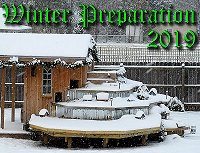 This is a followup to our article "Winter Preparation, 2019. That article describes the steps we took to prepare our garden railroad for several months of cold, windy weather. This is a followup to our article "Winter Preparation, 2019. That article describes the steps we took to prepare our garden railroad for several months of cold, windy weather.
Every year in my newsletter, I come up with a list of things that garden railroaders or potential garden railroaders can do during the cold months. Planning is always near the top of the list, as well as repairing trains, cleaning wheels, and building models.
Since we're still finishing our planned right-of-way on the raised-platform railroad we started in 2017, it's not hard to imagine what we're up to.
 If you've been following our account, you'll remember that we had initially planned a three-level railroad, with loops on all three levels, but room for towns, industries, and a certain amount of operation on the lower level. If you've been following our account, you'll remember that we had initially planned a three-level railroad, with loops on all three levels, but room for towns, industries, and a certain amount of operation on the lower level.
The graphic to the right shows the basic idea. It was a scale drawing when it started out, but almost all of the measurements have changed in execution, so take it as a general guideline to what we're trying to accomplish.
Also something I wasn't sure would happen when we started is that the waterfall feature essentially cuts the lower level in half. That allowed me to build one part of the level in 2019. When the other part is built, a bridge will connect the two sections.
 In the photo to the right, the lower part coming out toward you, is the first part of the lower level, built in late 2019. The long red line should give you some idea of the path I have in mind for the track on the rest of that level. In the photo to the right, the lower part coming out toward you, is the first part of the lower level, built in late 2019. The long red line should give you some idea of the path I have in mind for the track on the rest of that level.
The dotted arch near the left side shows approximately where the train will enter this side of the train shed. It will travel straight through and come out the other side, the same as the other two levels.
The little vertical lines are just there to give you an idea of how the right of way will be raised over the ground level. They do not represent physical posts. You can hopefully see all of that more clearly if you click on the photo to see a bigger version.
 If all I wanted was more track on the other side, I could, technically, just add some posts and stringers over there, the way we describe things in our "Simple Raised Railroad" article. If all I wanted was more track on the other side, I could, technically, just add some posts and stringers over there, the way we describe things in our "Simple Raised Railroad" article.
But that wouldn't give me the room for towns and operations that I would like to have. And, based on experience building both, it would require almost as much work as installing one more platform.
Minimum Requirements for the Last Platform
So far, each bit of platform I have built for this railroad has followed basic rules for deck construction, so I didn't need to worry about things shifting out of alignment. Also, I can step on the larger platforms if I need to, say, to clear the track on the upper levels, or to wire lighting to my buildings there.
Using the materials I've had success with so far, that includes:
 Sinking the posts at least 24" into the ground for stability and to get them below central Ohio's frost line. Sinking the posts at least 24" into the ground for stability and to get them below central Ohio's frost line.
- Making sure the 2"x6" joists never have a span longer than 6'.
- Making sure the 2"x6" frame pieces never have a span longer than 6'
- Making sure the 2"x6" frame pieces are no more than 24" apart (so my 2"x6" decking boards don't get "springy." If I was using 5/4" decking boards, the frame pieces would have to be closer, say 16".)
- Making sure my joists and frame do not protrude beyond the last post more than 12"
The other non-negotiable is that I wanted a minimum of 10'-diameter curves so I could run my longer pieces. Unfortunately, this DOES mean that there will be an area within the curves on one end that I won't be able to reach with my feet on the ground. Still, there are a dozen ways around that, which I will hopefully get to later this year.
How Big Should the Last Platform Be?
Keeping the factors above in mind, I also wanted the platform to provide a backdrop to the pond, so it will wrap around a bit.
The following graphic shows one possible solution that keeps all of the above constraints in mind. You'll notice immediately that the posts aren't all in a straight line, etc. That's partially a result of working around an existing structure and partially the result of wanting the shape of the railroad to seem more "organic."

In the graphic, the construction and right-of-ways that are completed are shown in gray. The joists which will support the frame are shown in black. The frame boards are shown in brown. The big fat dotted line, of course, represents the proposed right of way.
I could make it a bit smaller, such as shown below. It would save digging several post holes and cut down on materials, but it would reduce options for accessories and operations.

The east-to-west measureent (top to bottom in the pictures) can't get that much smaller because the right of way still has to wrap around the existing structure. In addition, the platform has to be at least 11' deep to support my 10'-diameter curves.
So any real shrinkage of the plan would affect the north-to-south measurement (left to right in the picture). But the truth is, we have plenty of room in that direction. Since this is the last piece of the last outdoor railroad I ever intend to build for myself, I'm inclined to think that having that extra few feet going off to the right would be a good idea. Maybe I'll start on the end I know I'm going to build and see how it goes. :-)
The big version shown two drawings above would give the lower loop a maximum of about an 80' right of way, which would allow me to run long trains without the effect of the locomotive chasing the caboose. I will miss the "train going away and coming back again" effect we had on the modified dogbone of our old railroad (which had about 160' of right of way). But, again, I won't miss the maintenance.
Making the Grade
One thing not evident from the photos or the plans is how much the yard slopes between the eastern and the western edge. The western edge of the railroad will be between 6" and 10" further off the ground than the part I've built so far. That's actually a benefit, since it will bring the right of way closer to eye level for most of our young visitors and add some variety for the rest of us.
Keep in Touch
In the meantime, I've put away my Christmas-themed trains and am working on storage options for my rolling stock and accessories. But I still have at least one train ready to go at all times, and if the waterfall isn't frozen, I can plug it in as well. So if you're headed toward or past Springfield, Ohio, please let me know, and I'll see if we can work out a quick visit.
Finally, please let us know about your ongoing projects. Ask questions, send corrections, suggest article ideas, send photos, whatever you think will help you or your fellow railroaders. In the meantime, enjoy your trains, and especially enjoy any time you have with your family in the coming weeks,
Paul Race
FamilyGardenTrains.com
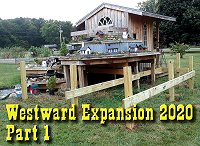 Proceed to "Westward Expansion, 2020, Part 1" - With a lumber shortage and warm weather running out, we revised our plans for the next addition, bought what decent lumber we could find, dug holes, installed posts, and attached joists. Hopefully we'll be able to get the lumber we need to finish the platform before cold weather sets in. Proceed to "Westward Expansion, 2020, Part 1" - With a lumber shortage and warm weather running out, we revised our plans for the next addition, bought what decent lumber we could find, dug holes, installed posts, and attached joists. Hopefully we'll be able to get the lumber we need to finish the platform before cold weather sets in.
Click on the following link to see our status as of late September, 2020.
https://familygardentrains.com/newbost/20_09_western_expansion_1/20_09_30_western_expansion1.htm
 Proceed to "Train Storage Solutions, 2020" - Using periods of cold weather to get things sorted in the garage, including shelf building and tips for schlepping trains from storage to the tracks. Proceed to "Train Storage Solutions, 2020" - Using periods of cold weather to get things sorted in the garage, including shelf building and tips for schlepping trains from storage to the tracks.
Click on the following link to see our status as of late January, 2020.
https://familygardentrains.com/newbost/20_1_19_shelves/shelves.htm
 Return to "Winter Preparation, 2019" - After the big open railroad event, we try to prepare the railroad for the cold months, including populating the railroad with North States bird feeders so it doesn't look empty, adding an air pump and bubblers to the pond, and more. Return to "Winter Preparation, 2019" - After the big open railroad event, we try to prepare the railroad for the cold months, including populating the railroad with North States bird feeders so it doesn't look empty, adding an air pump and bubblers to the pond, and more.
Click on the following link to see our status as of early December, 2019.
https://familygardentrains.com/newbost/19_11_24_winter_prep/19_11_24_winter_prep.htm
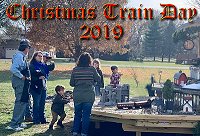 Return to "Christmas Train Day, 2019" - Three years after starting a garden railroad in our new home, we host another Christmas-themed open railroad, giving many families a jump start on Christmas celebrations and sharing the experience of running trains with lots of kids. Return to "Christmas Train Day, 2019" - Three years after starting a garden railroad in our new home, we host another Christmas-themed open railroad, giving many families a jump start on Christmas celebrations and sharing the experience of running trains with lots of kids.
Click on the photo to see a brief record of our busiest weekend in November, 2019.
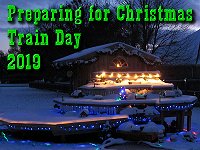 Return to "Preparing for Christmas Train Day 2019" - Wrapping up construction projects for 2019 and getting ready for our annual Christmas-themed open railroad. Includes new lighting and other features, providing a temporary home for a Hogwarts Express train, weather issues, and more. Click to go to article. Return to "Preparing for Christmas Train Day 2019" - Wrapping up construction projects for 2019 and getting ready for our annual Christmas-themed open railroad. Includes new lighting and other features, providing a temporary home for a Hogwarts Express train, weather issues, and more. Click to go to article.
Click on the following link to see our progress of mid-November, 2019.
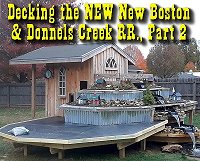 Return to Decking the NEW New Boston and Donnels Creek Part 2 - Getting the next part of the railroad ready to install trains. Includes installing 2"x6" decking, vinyl sheeting, edges to hold back the gravel, and corrugated steel panels. It's not done, but it will give us another place to set up trains for our next Christmas-themed open railroad. Return to Decking the NEW New Boston and Donnels Creek Part 2 - Getting the next part of the railroad ready to install trains. Includes installing 2"x6" decking, vinyl sheeting, edges to hold back the gravel, and corrugated steel panels. It's not done, but it will give us another place to set up trains for our next Christmas-themed open railroad.
Click on the photo to see our status as of late October, 2019.
 Return to "Framing the NEW New Boston and Donnels Creek RR - Part 7" - Installing posts, joists, framing, and decking for the eastern expansion of the NEW New Boston and Donnels Creek. Although this installation was complicated by having to fit into an existing framework, the methods used could work for any raised-platform railroad. Return to "Framing the NEW New Boston and Donnels Creek RR - Part 7" - Installing posts, joists, framing, and decking for the eastern expansion of the NEW New Boston and Donnels Creek. Although this installation was complicated by having to fit into an existing framework, the methods used could work for any raised-platform railroad.
Click on the following link to see our progress of early October, 2019.
 Return to "Planning the NEW New Boston and Donnels Creek RR - Part 5" - Once the major components of the water feature were installed and tested, we decided to add one more bit of railroad proper before our "Christmas Train Day," this November. The addition, about 5'x11', will allow us to put a small train and some scenery closer to eye level for youngsters. Eventually it will be part of the larger plan that will allow us to run our bigger cars and locomotives. Return to "Planning the NEW New Boston and Donnels Creek RR - Part 5" - Once the major components of the water feature were installed and tested, we decided to add one more bit of railroad proper before our "Christmas Train Day," this November. The addition, about 5'x11', will allow us to put a small train and some scenery closer to eye level for youngsters. Eventually it will be part of the larger plan that will allow us to run our bigger cars and locomotives.
Click on the photo to see our plans for the next addition, as of late September, 2019.
 Return to Waterscaping Part 4. - Installing the last connecting pool, so the whole planned waterfall is complete except for dirtscaping and planting. Return to Waterscaping Part 4. - Installing the last connecting pool, so the whole planned waterfall is complete except for dirtscaping and planting.
The process included checking the pump, extending the hoses, rescuing toads, building the platform, trimming the platform, testing the pool's location, etc.
Click the photo to go to the article.
 Return to "Waterscaping, Part 3" - After seven months of crazy long work hours, I finally got some free time to continue working on the railroad. Weather permitting, I often worked all the live-long day. This article describes installing two posts that will eventually support the last connecting pool, then digging the big hole for the in-ground pond, complicated by a three-month drought that turned the ground to concrete. Return to "Waterscaping, Part 3" - After seven months of crazy long work hours, I finally got some free time to continue working on the railroad. Weather permitting, I often worked all the live-long day. This article describes installing two posts that will eventually support the last connecting pool, then digging the big hole for the in-ground pond, complicated by a three-month drought that turned the ground to concrete.
Click on the photo to see our progress as of mid-September, 2019.
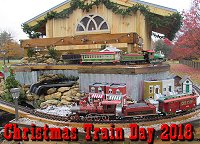 Return to Christmas Train Day, 2018 - After two years without our traditional Christmas Train Day (something we did from 2008 through 2015), we were anxious to get started again, even without a huge right of way to show off. The kids' trains, the extra Thomas railroad, the popcorn popper and two Bachmann Christmas trains got a big workout. And the visiting kids all loved it! Return to Christmas Train Day, 2018 - After two years without our traditional Christmas Train Day (something we did from 2008 through 2015), we were anxious to get started again, even without a huge right of way to show off. The kids' trains, the extra Thomas railroad, the popcorn popper and two Bachmann Christmas trains got a big workout. And the visiting kids all loved it!
Click on the photo to see a lot of last-minute preparations and some photos of the November 10, 2018 event itself.
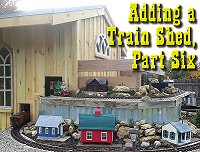 Return to "Adding a Train Shed Part 6" - Installing the board and batten siding on our train shed, installing the windows, installing the trim, testing the "tunnel entrances," and more. Return to "Adding a Train Shed Part 6" - Installing the board and batten siding on our train shed, installing the windows, installing the trim, testing the "tunnel entrances," and more.
By the way, going over lumber receipts in early 2019, I couldn't believe I was still siding the train shed in late October, and managed to have an open railroad in mid-November. It is a little crazy how fast things can go together if you have a deadline and a lot of gift cards.
Click on the photo to see our progress as of late October, 2018.
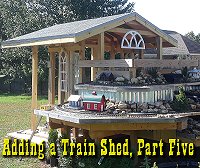 Return to "Adding a Train Shed Part 5" - Planning the doors, walls, and windows of our garden train shed. Return to "Adding a Train Shed Part 5" - Planning the doors, walls, and windows of our garden train shed.
Includes choosing the siding and windows, installing the door, painting the windowframes, and adding crosspieces to support the vertical siding boards.
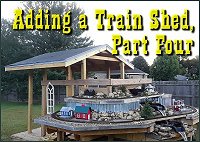 Return to "Adding a Train Shed Part 4" - Choosing and installing underlayment and drip edge to protect the sheathing until I can get the final roof installed. Return to "Adding a Train Shed Part 4" - Choosing and installing underlayment and drip edge to protect the sheathing until I can get the final roof installed.
Now the roof is waterproof enough to get us through the next couple of months at least, maybe more.
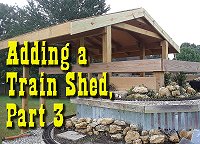 Return to "Adding a Train Shed Part 3" - Adding fascia, sheathing, and end trim to the in-progress train shed. Return to "Adding a Train Shed Part 3" - Adding fascia, sheathing, and end trim to the in-progress train shed.
I thought about bringing in helpers for this part, but a reader commented on how helpful it was to see how one person could do this sort of thing by himself, so I just kept plugging away.
Click on the photo to see our progress as of September 13, 2018
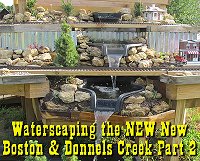 Return to "Waterscaping Part 2" - Getting this year's waterscaping project done (for now at least). Installing and dirtscaping the third level of the waterfall. Installing pump and filter, adding an extra container and modifying the ones we already had installed to keep the water running smoothly. And lots of other tweaking. Includes tips about introducing fish and plants, as well as other information about water features in general that you may find helpful. Return to "Waterscaping Part 2" - Getting this year's waterscaping project done (for now at least). Installing and dirtscaping the third level of the waterfall. Installing pump and filter, adding an extra container and modifying the ones we already had installed to keep the water running smoothly. And lots of other tweaking. Includes tips about introducing fish and plants, as well as other information about water features in general that you may find helpful.
Click on the photo to see our status as of August 5, 2018.
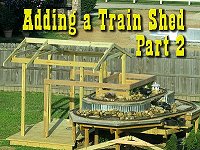 Return to "Adding a Train Shed Part 2" - Adding rafters to the frame of the in-progress train shed. Now it's starting to look like it might actually be a structure and not just a crazy collection of posts. Return to "Adding a Train Shed Part 2" - Adding rafters to the frame of the in-progress train shed. Now it's starting to look like it might actually be a structure and not just a crazy collection of posts.
The way we got the rafters and ridge board up wouldn't work for everybody, but it worked for us, and hopefully will help other folks to "think outside the box" - literally in this case.
Click on the photo to see our progress as of July 14, 2018.
 Return to "Adding a Train Shed Part 1" - What started out as a simple addition of a deck to stand on when putting trains on the track got a little more ambitious when I realized that JUST installing the deck this year would require more work next year. So we framed out what we planned to be a train shed attached to the railroad. If it ever gets finished, I can easily put trains on the track at a moment's notice instead of schlepping them out from the garage. Return to "Adding a Train Shed Part 1" - What started out as a simple addition of a deck to stand on when putting trains on the track got a little more ambitious when I realized that JUST installing the deck this year would require more work next year. So we framed out what we planned to be a train shed attached to the railroad. If it ever gets finished, I can easily put trains on the track at a moment's notice instead of schlepping them out from the garage.
Click on the photo to see our status as of July 9, 2018.
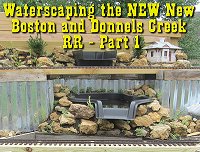 Return to "Waterscaping the NEW New Boston and Donnels Creek Part 1," our article on getting the top two layers of the waterfall on solid footing and getting the third layer framed. After we finish decking and dirtscaping the third layer, we will probably add a washbasin or something for the water to flow into, then add a pump to get the waterfall flowing. No big pond until next year at least - too many other projects. Return to "Waterscaping the NEW New Boston and Donnels Creek Part 1," our article on getting the top two layers of the waterfall on solid footing and getting the third layer framed. After we finish decking and dirtscaping the third layer, we will probably add a washbasin or something for the water to flow into, then add a pump to get the waterfall flowing. No big pond until next year at least - too many other projects.
Click on the photo to see our progress as of June 13, 2018.
 Return to "Dirtscaping the NEW New Boston and Donnels Creek RR, Part 2. - Adding barriers to keep the rocks, dirt, and plants where they're supposed to go, placing platforms and running wiring for buildings, adding rocks, dirt, and plants to the upper level of the railroad. Return to "Dirtscaping the NEW New Boston and Donnels Creek RR, Part 2. - Adding barriers to keep the rocks, dirt, and plants where they're supposed to go, placing platforms and running wiring for buildings, adding rocks, dirt, and plants to the upper level of the railroad.
Click on the photo to see our status as of June 1, 2018.
 Return to "Adding Raised Roadbed to the NEW New Boston and Donnels Creek, Part 2" - Trimming the corners off the roadbed on the upper layer and cutting the pieces that will support the curves on the middle layer. We need to get the upper two tiers of the pond installed before we totally complete this step, so the article doesn't quite show the finished product. You'll see it later as part of other articles. Return to "Adding Raised Roadbed to the NEW New Boston and Donnels Creek, Part 2" - Trimming the corners off the roadbed on the upper layer and cutting the pieces that will support the curves on the middle layer. We need to get the upper two tiers of the pond installed before we totally complete this step, so the article doesn't quite show the finished product. You'll see it later as part of other articles.
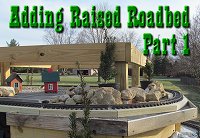 Return to "Adding Raised Roadbed to the NEW New Boston and Donnels Creek RR, Part 1" - Sorting out our priorities for the spring and summer of 2018. There a lot of little chores we really should get done before we start on the next big addition. Click to see our plans as of February 27, 2018. Return to "Adding Raised Roadbed to the NEW New Boston and Donnels Creek RR, Part 1" - Sorting out our priorities for the spring and summer of 2018. There a lot of little chores we really should get done before we start on the next big addition. Click to see our plans as of February 27, 2018.
Click on the photo to see our status as of February 20, 2018
 Return to "2018: Springing into Spring on the NEW New Boston & Donnels Creek RR." - Sorting out our priorities for the spring and summer of 2018. There a lot of little chores we really should get done before we start on the next big addition. Click to see our plans as of February 27, 2018. Return to "2018: Springing into Spring on the NEW New Boston & Donnels Creek RR." - Sorting out our priorities for the spring and summer of 2018. There a lot of little chores we really should get done before we start on the next big addition. Click to see our plans as of February 27, 2018.
Click on the photo to see our status as of February 20, 2018
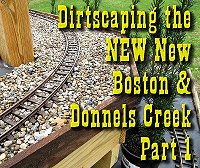 Return to "Dirtscaping the NEW New Boston and Donnels Creek RR, Part 1. - Putting edging around the existing "layers" of the new railroad, and beginning to add gravel and rocks. There were a few test runs, but we got stopped early by bad weather before we could dump the rest of the rocks, gravel, and dirt, much less plant the plants we hoped to get in before snowfall. Return to "Dirtscaping the NEW New Boston and Donnels Creek RR, Part 1. - Putting edging around the existing "layers" of the new railroad, and beginning to add gravel and rocks. There were a few test runs, but we got stopped early by bad weather before we could dump the rest of the rocks, gravel, and dirt, much less plant the plants we hoped to get in before snowfall.
Click on the photo to see our status as of November 21, 2017
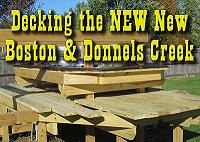 Return to "Decking the NEW New Boston and Donnels Creek RR - Decking the 'middle layer' of our proposed three-tier outdoor railroad. Prepping more track, laying out track and decking to make certain we have measurements correct, installing most of the remaining decking for this layer. Return to "Decking the NEW New Boston and Donnels Creek RR - Decking the 'middle layer' of our proposed three-tier outdoor railroad. Prepping more track, laying out track and decking to make certain we have measurements correct, installing most of the remaining decking for this layer.
Click on the photo to see our status as of October 25, 2017
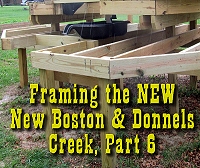 Return to "Framing the NEW New Boston and Donnels Creek RR, Part 6" - Modifying and finishing the framing on the second layer, cantilevering, using R3 track versus all other pre-curved track formats, finalizing the track plan, why painting the track makes old and new track blend better, and more. This will be the last bit of "framing" in 2017, and it worked out well, considering. Return to "Framing the NEW New Boston and Donnels Creek RR, Part 6" - Modifying and finishing the framing on the second layer, cantilevering, using R3 track versus all other pre-curved track formats, finalizing the track plan, why painting the track makes old and new track blend better, and more. This will be the last bit of "framing" in 2017, and it worked out well, considering.
Click on the photo to see our status as of October 15, 2017
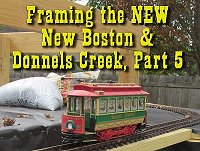 Return to "Framing the NEW New Boston and Donnels Creek RR, Part 5" - Spreading the billboard-sourced vinyl underlayment on the top layer. Prepping used Aristo track for (hopefully) many more years of service. Laying the first loop of track, attaching power wires with spade terminals, and testing conductivity with a Bachmann streetcar. Return to "Framing the NEW New Boston and Donnels Creek RR, Part 5" - Spreading the billboard-sourced vinyl underlayment on the top layer. Prepping used Aristo track for (hopefully) many more years of service. Laying the first loop of track, attaching power wires with spade terminals, and testing conductivity with a Bachmann streetcar.
Click on the photo to see our status as of October, 10, 2017
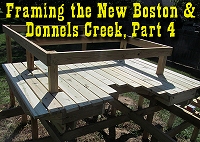 Return to "Framing the NEW New Boston and Donnels Creek RR, Part 4" - Planning and running the decking for the top layer, testing the track plan, checking clearances, prepping used track with new railjoiners, examining the vinyl I ordered to go over the decking, and more. Return to "Framing the NEW New Boston and Donnels Creek RR, Part 4" - Planning and running the decking for the top layer, testing the track plan, checking clearances, prepping used track with new railjoiners, examining the vinyl I ordered to go over the decking, and more.
Click on the photo to see our status as of September 26, 2017
 Return to "Framing the NEW New Boston and Donnels Creek RR, Part 3" -
Getting the frame finished on the top layer, ordering other things I'd need eventually, deciding on materials for the decking on the top layer (at least). Return to "Framing the NEW New Boston and Donnels Creek RR, Part 3" -
Getting the frame finished on the top layer, ordering other things I'd need eventually, deciding on materials for the decking on the top layer (at least).
Click on the photo to see our status as of September 17, 2017
 Return to "Framing the NEW New Boston and Donnels Creek RR, Part 2" -
Once I had the overall frame relatively solid, I hooked up the underground power lines to two GFI plugs that should be in easy reach once everything is finished. I also decided to frame out the top railroad layer while I could still access the center of the railroad easily. Because I was running out of vertical space, I reconfigured that layer. Then after I got the "core" pieces on, I changed my plan again. But the whole thing is getting easier and easier to visualize, and is getting closer to complete with every board I cut and fasten on. Return to "Framing the NEW New Boston and Donnels Creek RR, Part 2" -
Once I had the overall frame relatively solid, I hooked up the underground power lines to two GFI plugs that should be in easy reach once everything is finished. I also decided to frame out the top railroad layer while I could still access the center of the railroad easily. Because I was running out of vertical space, I reconfigured that layer. Then after I got the "core" pieces on, I changed my plan again. But the whole thing is getting easier and easier to visualize, and is getting closer to complete with every board I cut and fasten on.
Click on the photo to see our status as of September 7, 2017
 Return to "Framing the NEW New Boston and Donnels Creek RR, Part 1" -
Once I started dropping posts in the holes and screwing things together, I didn't want to stop before I had the basic frame built (for one thing, the wood warps less once it's fastened in place). Now the folks driving down the street past our house (we're on a corner lot) probably wonder if I'm building an elaborate chicken coop, but that's fine with me. I still need to make a few more lumber runs and do a lot more cutting and sawing, but having the basic frame in place should make the next bits a lot easier. Return to "Framing the NEW New Boston and Donnels Creek RR, Part 1" -
Once I started dropping posts in the holes and screwing things together, I didn't want to stop before I had the basic frame built (for one thing, the wood warps less once it's fastened in place). Now the folks driving down the street past our house (we're on a corner lot) probably wonder if I'm building an elaborate chicken coop, but that's fine with me. I still need to make a few more lumber runs and do a lot more cutting and sawing, but having the basic frame in place should make the next bits a lot easier.
Click on the photo to see our status as of August 10, 2017
 Return to "Breaking Ground on the NEW New Boston and Donnels Creek" -
Okay, in case you wondered if we'd ever get started on the thing, we broke ground in July, using a manual post-hole digger. Well two manual post-hole diggers. But by the end of this article, we're ready for the posts to start going in. Return to "Breaking Ground on the NEW New Boston and Donnels Creek" -
Okay, in case you wondered if we'd ever get started on the thing, we broke ground in July, using a manual post-hole digger. Well two manual post-hole diggers. But by the end of this article, we're ready for the posts to start going in.
Click on the photo to see our status as of the end of July, 2017
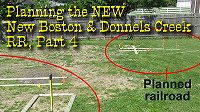 Return to "Planning the NEW New Boston and Donnels Creek, Part 4" -
Well, the rented post-hole digger fell through, so we dug our vegetable garden with a manual post-hole digger (the scissors kind). In addition, I stake out where the railroad was going to be. Twice. And tweaked the plans again. Sorry about the redo's, but sometimes just walking around the yard trying to visualize things makes me reconsider something that seemed "settled" only a few days before. Return to "Planning the NEW New Boston and Donnels Creek, Part 4" -
Well, the rented post-hole digger fell through, so we dug our vegetable garden with a manual post-hole digger (the scissors kind). In addition, I stake out where the railroad was going to be. Twice. And tweaked the plans again. Sorry about the redo's, but sometimes just walking around the yard trying to visualize things makes me reconsider something that seemed "settled" only a few days before.
Click on the photo to see what we were considering as of late May, 2017
 Return to "Planning the NEW New Boston and Donnels Creek, Part 3" -
We have still not broken ground. In part because we plan to rent a post-hole digger and dig the post holes for our raised vegetable garden and the first phase of the garden railroad at the same time, and we don't have enough lumber on hand yet. (If we didn't break it down into multiple trips, we'd be blowing out the shocks on our minivan.) In the meantime, we used a line level to see if the slope of the back yard was as bad as we thought it was (it's worse), and we did other site preparation, including planting a whole bunch of spruce tree seedlings to eventually give us some privacy in our side and back yard. Plus, I'm still wavering a little on the "where-to-start-first" issue. Return to "Planning the NEW New Boston and Donnels Creek, Part 3" -
We have still not broken ground. In part because we plan to rent a post-hole digger and dig the post holes for our raised vegetable garden and the first phase of the garden railroad at the same time, and we don't have enough lumber on hand yet. (If we didn't break it down into multiple trips, we'd be blowing out the shocks on our minivan.) In the meantime, we used a line level to see if the slope of the back yard was as bad as we thought it was (it's worse), and we did other site preparation, including planting a whole bunch of spruce tree seedlings to eventually give us some privacy in our side and back yard. Plus, I'm still wavering a little on the "where-to-start-first" issue.
Click on the photo to see what we were considering as of late April, 2017
 Return to "Planning the NEW New Boston and Donnels Creek, Part 2" -
More plans. We've moved on from the 2"x6" roadbed-on-posts to a sort of "train-table-outside" plan. Our goals include low-maintenance, high interest, and high reliability. We're also trying to get around having a thousand dollars' worth of dirt hauled into the back yard. If you want to get some idea of what our planning process looks like, reading these through in sequence may help. Or it may drive you crazy. Return to "Planning the NEW New Boston and Donnels Creek, Part 2" -
More plans. We've moved on from the 2"x6" roadbed-on-posts to a sort of "train-table-outside" plan. Our goals include low-maintenance, high interest, and high reliability. We're also trying to get around having a thousand dollars' worth of dirt hauled into the back yard. If you want to get some idea of what our planning process looks like, reading these through in sequence may help. Or it may drive you crazy.
Click on the photo to see what we were considering in early April, 2017
 Return to "Planning the NEW New Boston and Donnels Creek, Part 1" -
If you're subscribed to our newsletter, you know that we moved just after Thanksgiving in 2016, leaving behind most of the track, a few of the bird feeders, and one Bachmann train set for the new owners. We also left behind a high-maintenance garden that we do not intend to replicate at the new place. This is the first chapter of a new chapter in our lives, which we hope will include a lot of "lessons learned." But first, some serious landscaping had to take place. Return to "Planning the NEW New Boston and Donnels Creek, Part 1" -
If you're subscribed to our newsletter, you know that we moved just after Thanksgiving in 2016, leaving behind most of the track, a few of the bird feeders, and one Bachmann train set for the new owners. We also left behind a high-maintenance garden that we do not intend to replicate at the new place. This is the first chapter of a new chapter in our lives, which we hope will include a lot of "lessons learned." But first, some serious landscaping had to take place.
Click on the photo to see what we were considering in March, 2017
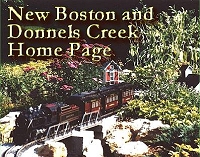 Return to the New Boston and Donnels Creek RR Page - This is the page describing Paul Race's progress and frequent rework on his own garden railroad, started on a shoe-string budget in 1998, later expanded, and later refurbished several times as issues arose. Issues that Paul hopes to avoid by building the next iteration above ground. Return to the New Boston and Donnels Creek RR Page - This is the page describing Paul Race's progress and frequent rework on his own garden railroad, started on a shoe-string budget in 1998, later expanded, and later refurbished several times as issues arose. Issues that Paul hopes to avoid by building the next iteration above ground.
Click on the photo to see the home page of Paul's railroad.
 Return to Family Garden Trains' Home Page - The home page with links to all the other stuff, including design guidelines, construction techniques, structure tips, free graphics, and more. Return to Family Garden Trains' Home Page - The home page with links to all the other stuff, including design guidelines, construction techniques, structure tips, free graphics, and more.
To read more, or to look at recommended Garden Railroading and Big Indoor Train products, please click on the index pages below.
| 
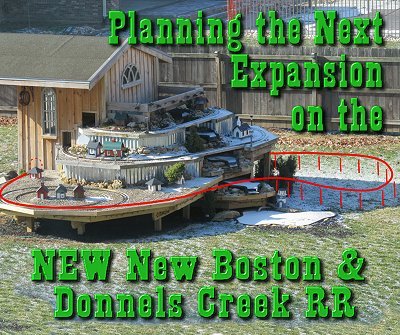















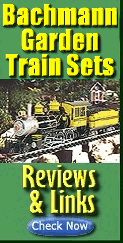



















































 Proceed to "Westward Expansion, 2020, Part 1"
Proceed to "Westward Expansion, 2020, Part 1" Proceed to "Train Storage Solutions, 2020"
Proceed to "Train Storage Solutions, 2020" Return to "Christmas Train Day, 2019"
Return to "Christmas Train Day, 2019" Return to "Preparing for Christmas Train Day 2019"
Return to "Preparing for Christmas Train Day 2019" Return to Decking the NEW New Boston and Donnels Creek Part 2
Return to Decking the NEW New Boston and Donnels Creek Part 2 Return to "Framing the NEW New Boston and Donnels Creek RR - Part 7"
Return to "Framing the NEW New Boston and Donnels Creek RR - Part 7" Return to "Planning the NEW New Boston and Donnels Creek RR - Part 5"
Return to "Planning the NEW New Boston and Donnels Creek RR - Part 5" Return to Waterscaping Part 4.
Return to Waterscaping Part 4. Return to "Waterscaping, Part 3"
Return to "Waterscaping, Part 3" Return to Christmas Train Day, 2018
Return to Christmas Train Day, 2018 Return to "Adding a Train Shed Part 6"
Return to "Adding a Train Shed Part 6" Return to "Adding a Train Shed Part 5"
Return to "Adding a Train Shed Part 5" Return to "Adding a Train Shed Part 4"
Return to "Adding a Train Shed Part 4" Return to "Adding a Train Shed Part 3"
Return to "Adding a Train Shed Part 3" Return to "Waterscaping Part 2"
Return to "Waterscaping Part 2" Return to "Adding a Train Shed Part 2"
Return to "Adding a Train Shed Part 2" Return to "Adding a Train Shed Part 1"
Return to "Adding a Train Shed Part 1" Return to "Waterscaping the NEW New Boston and Donnels Creek Part 1,"
Return to "Waterscaping the NEW New Boston and Donnels Creek Part 1,"  Return to "Dirtscaping the NEW New Boston and Donnels Creek RR, Part 2.
Return to "Dirtscaping the NEW New Boston and Donnels Creek RR, Part 2. Return to "Adding Raised Roadbed to the NEW New Boston and Donnels Creek, Part 2"
Return to "Adding Raised Roadbed to the NEW New Boston and Donnels Creek, Part 2" Return to "Adding Raised Roadbed to the NEW New Boston and Donnels Creek RR, Part 1"
Return to "Adding Raised Roadbed to the NEW New Boston and Donnels Creek RR, Part 1" Return to "2018: Springing into Spring on the NEW New Boston & Donnels Creek RR."
Return to "2018: Springing into Spring on the NEW New Boston & Donnels Creek RR." Return to "Dirtscaping the NEW New Boston and Donnels Creek RR, Part 1.
Return to "Dirtscaping the NEW New Boston and Donnels Creek RR, Part 1. Return to "Decking the NEW New Boston and Donnels Creek RR
Return to "Decking the NEW New Boston and Donnels Creek RR Return to "Framing the NEW New Boston and Donnels Creek RR, Part 6"
Return to "Framing the NEW New Boston and Donnels Creek RR, Part 6" Return to "Framing the NEW New Boston and Donnels Creek RR, Part 5"
Return to "Framing the NEW New Boston and Donnels Creek RR, Part 5" Return to "Framing the NEW New Boston and Donnels Creek RR, Part 4"
Return to "Framing the NEW New Boston and Donnels Creek RR, Part 4" Return to "Framing the NEW New Boston and Donnels Creek RR, Part 3"
Return to "Framing the NEW New Boston and Donnels Creek RR, Part 3" Return to "Framing the NEW New Boston and Donnels Creek RR, Part 2"
Return to "Framing the NEW New Boston and Donnels Creek RR, Part 2" Return to "Framing the NEW New Boston and Donnels Creek RR, Part 1"
Return to "Framing the NEW New Boston and Donnels Creek RR, Part 1" Return to "Breaking Ground on the NEW New Boston and Donnels Creek"
Return to "Breaking Ground on the NEW New Boston and Donnels Creek" Return to "Planning the NEW New Boston and Donnels Creek, Part 4"
Return to "Planning the NEW New Boston and Donnels Creek, Part 4" Return to "Planning the NEW New Boston and Donnels Creek, Part 3"
Return to "Planning the NEW New Boston and Donnels Creek, Part 3" Return to "Planning the NEW New Boston and Donnels Creek, Part 2"
Return to "Planning the NEW New Boston and Donnels Creek, Part 2" Return to "Planning the NEW New Boston and Donnels Creek, Part 1"
Return to "Planning the NEW New Boston and Donnels Creek, Part 1" Return to the New Boston and Donnels Creek RR Page
Return to the New Boston and Donnels Creek RR Page Return to Family Garden Trains' Home Page
Return to Family Garden Trains' Home Page